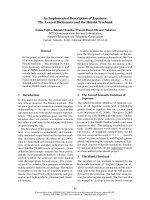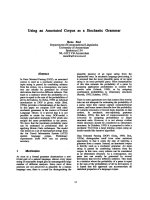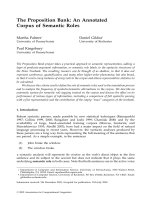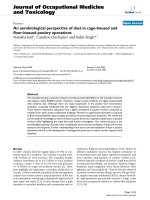AN ANNOTATED LIST OF A COLLECTION OF REPTILES FROM SOUTHERN CALIFORNIA AND NORTHERN LOWER CALIFORNIA, MEEK 1905
Bạn đang xem bản rút gọn của tài liệu. Xem và tải ngay bản đầy đủ của tài liệu tại đây (1.94 MB, 25 trang )
FIELD COLUMBIAN MUSEUM
PUBLICATION 104.
ZOOLOGICAL SERIES.
VOL. VII, No.
AN ANNOTATED
LIST OF A COLLECTION
OF REPTILES FROM SOUTHERN
CALIFORNIA AND NORTHERN
LOWER
i.
CALIFORNIA.
BY
SETH EUGENE MEEK, Ph. D.
Assistant Curator of
Department.
D. G. ELLIOT, F. R.
S. E.
Curator of Department.
CHICAGO, U.
S.
November, 1905.
A.
ANNOTATED LIST OF A COLLECTION OF REPTILES FROM
SOUTHERN CALIFORNIA AND NORTHERN LOWER
CALIFORNIA.
By SETH
EUGENE MEEK,
Ph. D.
The following paper is based on a collection of Reptiles obtained
by Mr. Edmund Heller in southern California and northern Lower
California.
A
very complete account of the region in question,
accompanied by maps, is given by Professor D. G. Elliot in his papers*
on the Mammals collected by Mr. Heller in this same area. Mr.
Heller has furnished the writer valuable field notes, which have here
been incorporated; these notes are indicated by quotation marks.
I wish to acknowledge my indebtedness to Dr. L. Stejneger,
Curator of Reptiles in the U. S. National Museum, for assistance in
identifying a large portion of this collection.
as
One species of Crotalus, from Tombstone,
new in this paper.
Arizona,
is
also described
Family Testudiiiidas
PACIFIC TERRAPIN.
(Baird & Girard).
"This species is not rare in ponds along the Mojave River."
specimens were secured.
Clemmys marmorata
No
i
Qopherus agassizii (Cooper).
~~
-
1
DESERT TORTOISE.
Six specimens of this species were secured north of Daggett, in the
Calico mining district.
"They had apparently just emerged from
some being taken within a few feet of their
The burrows were usually made in light, gravelly soil, in
which they were sunk obliquely to a depth of about two feet. In
their winter hibernation,
burrows.
(2,500 to 3,500 feet altitude) they were found on a
peculiar slate-colored soil in the lower part of the tree yucca zone.
Soon after a shower they are said to be usually common, but during
the hottest months, when most of the vegetation is dormant, they
this locality
retreat to their
burrows and hibernate."
*Field Col. Mus. Pub. Zool. Ser. Vol. Ill, 199-206, 271-283.
3
FIELD COLUMBIAN
4
MUSEUM
Family Eublepharidse.
Coleonyx variegatus (Baird). BANDED GECKO.
One specimen of this species was secured at San Felipe, Lower
California.
Family Iguaiiidse.
Dipsosaurus dorsalis (Baird & Girard). CRESTED LIZARD.
"This lizard is very common about the sand dunes in Death ValTt
of mesquite.
ley, where it lives in burrows beneath the stems
of the mesquite, eating the foliage.
is often seen on the stems
This lizard was very abundant in mesquite thickets at the base of the
Panamint Mountains.
all
It is
apparently scarce in Lower California,
of the individuals seen there were taken."
Specimens were taken in California at Furnace Creek, Mesquite
Valley, Ballarat,
and Daggett, and
in
Lower
California at
San Felipe
Bay.
Uma notata Baird. SAND LIZARD.
PLATE I.
Uma notata* Baird is based on a small specimen
from the "Mojave
The description given by Baird is very short, and this,
supplemented by Cope in his work on North American Reptiles t, is
rather unsatisfactory.
The specimens in the collection studied by me
Desert."
agree fairly well with the above brief accounts of this species, except
in the number of femoral pores.
The number of these vary greatly.
The main row has from 23 to 31, while in many specimens there is a
partial
second row, which usually contains from
i
to 6 additional
Professor Cope gives 17 or 38 in the type.
I here append a
pores.
detailed description of the species, based on the material at hand,
and also a table of measurements. It is hoped this will aid some
in properly defining the species of this interesting
and
little
-known
group.
rather broad, depressed, its greatest width 2> to 2^3 in its
broad and depressed, the depressed arm not quite
reaching groin; the depressed leg reaches beyond gular fold to ear or
eye; occipital plate small, subtriangular, and separated from the
small plates of the supraocular region by four or five rows of scales
Body
length;
tail
;
*Proc. Acad. Nat. Sci., Phila., 1858, 257.
fRep. U. S. Nat. Mus. 1898, 277.
C/2
a
o
(/>
aft
y
a
?T
FIELD COLUMBIAN MUSEUM
6
of supraocular and
first
canthal
the
one
three
scales,
very small, the
parietal regions;
second largest; six scales forming a suborbital ridge, the fourth much
plates
on anterior third of head larger than those
the largest, the anterior scale of this ridge being separated from the
by five or six rows of small scales, the fourth scale by two
labials
rows; superior labials nine, inferior twelve or thirteen; the first five
labials margined by a row of flat scales much larger than those on
throat, a second row of large scales between this row and labials
posterior to fifth labial; scales on the anterior surface of humerus
large, pointed but not keeled; scales of throat and just back of gular
than the others on under- surf ace of the head; scales on
margin of gular fold slightly enlarged; eyelids margined with scalelike processes, and covered with minute scales; anterior margin of
femur and under surface of tibia with enlarged scales scales anterior
to femoral pores larger than those posterior free scales forming the
fringe, external side of sole and on fourth toe, larger than those on
second and third toes, those on first and fifth toes minute scales on
dorsal region small and rounded, those on belly flat and larger; lateral
scales smallest; anterior margin of the ear with narrow elongated
scales; scales on tail similar to those on body, becoming larger posteriorly males with enlarged post anal scales.
Color light reticulated with black, forming circles or ellipses on
the center of dorsal region, with a brown spot in the center of each
sides and head spotted with brown and black, under surface of head
white with black spots, usually forming three rows on each side,
and extending backwards, meeting in the center; throat with two
black crescents; a black lateral blotch, and a small black blotch
occasionally on each side just behind the inner femoral pores under
surface of tail with from three to seven black spots.
Below is given by Mr. Heller the coloration in life of an old male.
fold smaller
;
;
;
;
;
;
"Above creamy white blotched with irregular black blotches forming occelated spots with black centers, the black marking everywhere edged with ferruginous; anterior part of nape and occiput
without occellations, the dark spots becoming brownish; head above
banded irregularly with dusky; tail above brownish
color without occellations, anteriorly marked with black reticulations, posteriorly with rusty markings extending along median line to
the tip; forelegs spotted above with black and rusty on a brownish
clay ground, the spots becoming obsolete on the phalanges; hind legs
light brownish, clay spotted, with rusty on thighs; distally spotted
with dusky; sides of head spotted like nape; the sides of body with
a large median inky black spot; two similar spots before the hind
light brownish,
REPTILES FROM So. CALIF. AND L. CALIF.
MEEK
7
becoming golden distally; beneath
small
black
of
tail
a
at
base
spot margined with golden posterior
thigh
with
of
golden olive; sides of tail golden yellow;
thigh spotted
part
leg; thigh anteriorly light olive,
;
tip of chin rusty, forethroat dusky banded on whitish ground; throat
barred with black; fore part of chest behind collar spotted with olive
and blackish; belly and chest whitish; hind legs beneath the same,
with light olive wash; a blackish blotch posterior to beginning of
femoral pores on each side, tail below like the thighs, near the tip
crossed by a few black bar<=."
"This species was taken only in the drifting sand areas of the bed
It has the peculiar
of the Mojave River, where it is a common form.
habit of burying itself in the sand when pursued. The peculiar
fringe of scales along the toes evidently serves to give the lizard
sufficient speed over the loose sand to force its body beneath the surface.
The sharp depresssed snout
is
evidently another modification
in getting beneath the sand.
Usually the entire body is
of
Their peculiar
the
tail
the
but
buried,
protrudes.
tip
occasionally
to aid
it
mottled coloration does not render them protectively colored on the
white sand, but their peculiar mode of eluding pursuers renders this
unnecessary, and at the same time limits them to areas covered by
fine drifting sand.
"The food
of this species consists largely of the leaves of a for-
get-me-not (Cryptonthe), which is abundant among the sand dunes.
The young leaves of the desert willow (Chilopsis) are also eaten.
The insect food consists of caterpillars, ants, bees, etc. One specimen was seen several feet up on an oblique limb of a desert willow,
in search of the young leaves which were just budding."
Specimens were secured at Daggett, California.
Callisaurus ventralis (Hallowell). GRIDIRON-TAILED LIZARD.
"This is one of the most abundant species in southeastern California and the eastern half of the northern portion of Lower California.
At San
Felipe,
Lower
California, it
was the most abundant
It was
This species inhabits dry, sandy regions.
of
Death
in
floor
on
the
abundant
Valley,
sandy washes, and
very
on sandy mesas in the deserts, and in the mouths of canons at the
base of the Inyo and Panamint Mountains."
lizard observed.
Specimens were secured at the following localities: Keeler, Emigrant Canon, Mesquite Valley, Furnace Creek, Ballarat, Lone Willow
Springs, Pilot Knob, Lanes Mill, Owens Lake and Daggett, California; Trinidad, San Matias, San Felipe, Canon Esperanza, San
Antonio, Matomi, and Aguas Escondita, Lower California.
FIELD COLUMBIAN
8
MUSEUM
Crotaphytus baileyi Stejneger. BAILEY'S LIZARD.
"This lizard is very common on rocky ground in southeastern
California and south into Lower California to the foothills near San
It was also observed in Lower California at Trinidad and
Felipe Bay.
Canon Esperanza. In the Panamint Mountains it was common
everywhere in rocky ground from 2,000 to 8,000 feet, although on
In the Inyo
the east slope it was not observed below 4,000 feet.
Mountains this species was occasionally seen from the base to over
8,000 feet. Those at 8,000 feet were more grayish and smaller than
the ones living at lower elevations."
In all of the specimens taken there are two rows of scales between
Some are
the supraorbitals. This species varies much in color.
profusely spotted with white, others have very few spots. The
young usually have prominent white bars across the back, while in
adults from the same locality these bars are quite indistinct.
Owing
to the constancy of the two rows of scales between the supraorbitals,
I follow Dr. Stejneger in using the name proposed by him for this
lizard.
Specimens were secured at the following localities: Beveridge
^Canon, Coso Valley, Shepherd Canon, Emigrant Canon, Wild Rose
Springs, and Hannopee Canon, California; San Felipe and San
Salado,
Lower
California.
In the collections of the
Museum
are
specimens from Winslow and Tombstone, Arizona, and Grand JuncThese, with one exception (one from Winslow,
tion, Colorado.
two rows of scales between the supraocular. In
have
the
Arizona),
the exception there is but one scale, which extends across this space.
This is probably the accidental fusing of two scales.
Crotaphytus wislizenii Baird & Girard. LEOPARD LIZARD.
"This species is more active and wary than the preceding, with
which it is usually associated, though much less abundant. It was
not observed at a higher altitude than 7,000 feet. One individual
was seen in Lockwood Valley at 5,000 feet, and one in Cuddy Canon
lower down. These places are near Ft. Tejon." Two specimens were
taken at Owens Lake, California.
In the young the light bars on the back are more prominent, and
In life the
at this stage they much resemble the following species.
lighter colors are red or are deeply tinged with that color.
"The food of this species consists largely of smaller lizards, chiefly
species of Uta and Cnemidophorus."
Specimens were secured at the following places: Coso Valley,
Emigrant Canon, Furnace Creek, Wild Rose Springs, Coal Kilns,
REPTILES FROM So. CALIF. AND L. CALIF.
Lone Willow Springs,
Pilot
Knob, and Lanes
MEEK
Mill, California;
9
San
Quentin, Lower California.
Crotaphytus
"Common
silus Stejneger.
SHORT-NOSED LEOPARD LIZARD.
in the San Joaquin Valley north of Rose Station,
living in abandoned burrows of the KangarooPerodipus. They do not leave the level floor of the valley, but
extend to the base of the hills near the mouth of the Canon de las
where they are found
rat,
The species is very wary, which
and exposed nature of their habitat.
Uvas.
is
doubtless due to the open
All the stomachs
examined
contained grasshoppers.
were bright lemon yellow on the belly and under
and tail. Above they were cross-barred like
the young of C. wislizenii, of which their coloration is probably an
The adults
in life
surfaces of the limbs
arrested stage."
The throat of this species contains much less black than that of
the preceding. There is usually in the center a longitudinal dark
On the
stripe with a few irregular elongated blotches on each side.
throat of C. baileyi the black is arranged in several longitudinal bands.
Specimens in the collection were secured at Rose Station, California.
ALDERMAN LIZARD. CHUCK-WALLA.
the largest lizard native to the State of California.
It is
reported to be common in mid-summer in the rocky canons of the
mountains near Daggett, and in the rocky canons entering Death
Sauromalus ater DumeTil.
"This
is
This species is common in the Panamint and Inyo mounfrom their bases to about 6,000 feet. It is much sought for by
the Panamint Indians for food. Their method of hunting them
consists of searching the cracks in cliffs, from which retreats they are
secured by means of a wire hook inserted in their bodies.
It probably
nowhere exceeds an altitude of over 6,000 feet.
"This species is reported to occur in the summer in the desert
Valley.
tains,
ranges of the northern part of Lower California."
One specimen was taken at Beveridge Canon, one
two in Hannopee Canon, California.
at Furnace
Creek, and
Uta mearnsi Stejneger.
MEARNS' LIZARD.
This species is quite plentiful in the northern portion of Lower
California.
Specimens were collected at the following localities:
San Salado, San Matias, Canon Esperanza, Parral, and Matomi,
Lower
California.
FIELD COLUMBIAN
io
MUSEUM
LONG-TAILED UTA.
Uta graciosa (Hallowell).
"This rare species was observed only on trees and bushes_at San
Felipe, Lower California, where four specimens were taken. ^This
lizard apparently does not have a wide range."
Uta stansburiana Baird
&
Girard.
BROWN-SHOULDERED LIZARD.
This extremely variable lizard is very generally distributed in
"In the
southeastern California and northern Lower California.
Panamint and Inyo mountains it was found at an altitude of 8,000
It is also abundant in the San Joaquin Valley, and in the
feet.
mountains about Ft. Tejon, reaching on Mt. Pinos an altitude of
6,000 feet. This species appears to be at home in river washes, on
sandy soil, and on rocky ground. The color ranges from a dark blue
to a light gray, all being more or less profusely spotted with white.
In general, those taken on sandy soil are the lighest in color."
Specimens of this species were taken in the following named places
Mesquite Valley, Beveridge Canon, Coso Valley, Furnace Creek,
Ballarat, Coal Kilns, Lone Willow Springs, Pilot Knob, Daggett,
:
Mt. Pifios, Piru Creek, Ft. Tejon, California; Hansons Lagoon, El
Alamo, San Salado Canon, Trinidad, San Matias, Canon Esperanza,
Agua de las Fresas, San Felipe, San Antonio, Santa Rosa, Parral,
Matomi, and San Quentin, Lower California.
Uta microscutata Van Denburgh.
SMALL-SCALED UTA.
common
in the northern portion of Lower
The specimens in the collection vary from nearly a uniCalifornia.
form blue black to a gray, belly usually blue with a few white spots
This species
is
rather
on the margins.
They were taken as follows: San Salado Canon, San Matias,
Canon Esperanza, San Antonio, Parral, San Quentin, and Rosarito,
Lower California.
Sceloporus magister Hallowell. SCALY LIZARD.
This is the largest species of the genus included in this paper.
The length from tip of snout to vent is about 100 mm.
This species is common on rocky ledges and trunks of yuccas in
In the Panamint Mountains it is found at
southeastern California.
' '
an altitude of 7,500 feet."
Specimens were secured in the following localities: Lone Pine,
Emigrant Canon, Coal Kilns, Lone Willow Springs, Pilot Knob,
Little Owens' Lake, and Lanes Mill, California.
"A few individuals
were seen on yuccas in Antelope Valley near Manzana."
REPTILES FROM So. CALIF. AND L. CALIF.
n
MEEK
Sceloporus zosteromus Cope.
This large lizard is apparently distributed throughout the entire
peninsula of Lower California. This species resembles the preceding
and may prove to be only a variety of that species. Sceloporus clarkii
B & G, which does not occur in the region under discussion, is quite
distinct
the
from
museum
either.
From my study
of the material of this group in
am
led to accept the views of Dr. Stejneger.*
Specimens of this species were taken in the following localities:
San Jose, Matomi, Rosarito, and San Quentin, Lower California.
I
Sceloporus orcutti Stejneger. DUSKY SCALY LIZARD.
This lizard is common in the northern part of Lower California,
where it attains about the same size as does 5. zosteromus.
It was also observed by Mr. Heller to be quite common at Los
Encinos, Lower California.
Specimens were secured at the following localities: San Salado
Canon, Trinidad, San Matias, Agua de las Fresas, Canon Esperanza,
Parral,
Matomi, Rosarito, and San Antonio, Lower
California.
Sceloporus biseriatus Hallowell. FENCE LIZARD.
This very variable and widely distributed species
abundant
"It
is
is
quite as
any of the genus in the region treated of in this paper.
usually found on trees or shrubs, frequently at an altitude of
as
8,000 feet."
Specimens were secured at the following places: Beveridge Canon,
Lone Pine, Hot Springs, Coso Valley, Coal Kilns, Hannopee Canon,
Wild Rose Springs, Piru Creek, and Ft. Tejon, California; Hansons
Lagoon, Trinidad, San Jose, Santa Rosa, Rosarito Divide, and San
Antonio, Lower California.
This species was also seen by Mr. Heller at Santa Tomas and Los
Encinos, Lower California.
Sceloporus graciosus Baird & Girard. MOUNTAIN LIZARD.
This species has a considerable vertical range. "It was seen on
In the Inyo Mountains
Telescope Peak at an altitude of 10,500 feet.
was abundant on granite boulders and in sage brush at from 7,000
to 8,500 feet. A few were seen at Ramshaw Meadows at 9,000 feet,
and in Lockwood Valley near Ft. Tejon."
it
Specimens were secured at the following localities: Beveridge
Canon, Coal Kilns, Hot Springs, and Telescope Peak, California;
Agua de las Fresas, Vallecitos, and La Grulla, Lower California.
*N. A. Fauna, No.
7,
178.
FIELD COLUMBIAN MUSEUM
12
blainvillii Gray.
BLAINVILLE'S HORNED TOAD.
few specimens of this species were secured at Neenach and Mt.
Pinos, California, and, Trinidad and San Salado, Lower California.
Phrynosoma
A
Phrynosoma frontale Van Denburgh.
One specimen from Rose Station,
California.
A
horned toad,
was observed to be common in Lockwood
probably
were
These
a
peculiar wood-brown above, with the under
Valley.
surfaces bright chrome yellow in life."
this species
Phrynosoma platyrhinus Girard. DESERT HORNED TOAD.
This species is more abundantly distributed over Southern
Cali-
any other member of the genus. "It is usually found in
In the
the desert where the surface is stony, gravelly, or sandy.
Panamint Mountains it was found at the base to about 7,000 feet.
fornia than
Specimens of the desert horned toad were taken in the'following
places: Mesquite Valley, Coso Valley, Furnace Creek, Wild Rose
Springs, Coal Kilns, Pilot Knob, Antelope Valley, and Ballarat, California; San Felipe, Lower California.
"This species was found to be quite abundant at Palm Springs,
Lone Willow Springs, and on the gravelly washes and mesas throughout Death Valley."
Phrynosoma coronatum (Blainville).
One specimen from San Quentin, Lower
California.
Family
Qerrhonotus scincicauda (Skilton). ALLIGATOR LIZARD.
A few specimens of this species were secured near Ft. Tejon, and
Piru Creek, California, and at San Antonio, Lower California.
Gerrhonotus palmeri Stejneger. MOUNTAIN ALLIGATOR LIZARD.
Apparently not common, "generally found along creeks or in dry
meadows. A few were seen near Lone Pine, at an altitude of 9,000
feet."
A
few specimens were secured at Hot Springs, California.
REPTILES FROM So. CALIF. AND
L. CALIF.
MEEK
13
Family AimiellicUe.
Anniella pulchra Gray.
one at San
SILVERY FOOTLESS LIZARD.
San Salado Canon and
of this species was taken at
Jose in Lower California.
One specimen
Family Xantusiidse.
Xantusia vigilis Baird. DESERT NIGHT LIZARD.
"This species is found beneath the prostrate limbs of the yucca
In Lower California,
tree (Yucca arborescens) in the Mojave Valley.
at San Matias Pass, it inhabits the fallen trunks of a smaller yucca
tree.
This species was also observed beneath the prostrate limbs of
tree yuccas in the Antelope Valley, and at Piru Creek about the tree
yuccas on the east slope of the Inyo Mountains."
Specimens were secured at Lanes Mill, Piru Creek, Neenach, and
Mojave, California.
Family Teiidse.
Cnemidophorus
tigris Baird
&
Girard.
DESERT WHIPTAIL.
This species is very abundant in the southeastern part of California.
"It is found on the desert and on the mountain sides to the
lower edge of the Pinon zone."
sandy regions are
much
Individuals of this species living in
lighter in color than those living in the
The under surface of the light-colored ones is nearly
white, no spots on the chin, and the black or dark blue of the belly
being in blotches on its anterior half. The under surface of some of
mountains.
is nearly a uniform blue, with scarcely any
All grades are found between these two extremes.
trace of spots.
The color of the dorsal region varies greatly. On the young are six
longitudinal white lines, later white spots form between these lines.
the darker specimens
These spots increase in size until they extend to the light lines, and
thus are formed irregular, narrow, dark cross bars, the lines becoming
later quite or entirely obliterated.
Most of the species of this genus
undergo a similar change. The result is that species have been
unduly multiplied. Professor Cope noted this change in color pattern
FIELD COLUMBIAN
14
and regarded it not due to age, because
color pattern were not of equal size.
MUSEUM
all
specimens having the same
In this connection it must be remembered that cold-blooded animals do not, in general, grow as uniformly as do warm-blooded ones,
and so two lizards of the same age may differ greatly in size. The
color pattern of a particular stage may also develop quite independently of age. About all we can say in this connection is that one
particular pattern appears before another certain one does, and that
the earlier pattern is usually associated with the smaller individuals.
This genus of lizards is badly in need of careful revision, but this can
not be accomplished except with a large series of various ages of each
species.
Specimens of this species were secured in the following localities:
Mesquite Valley, Beveridge Canon, Lone Pine, Keeler, Coso Valley,
Emigrant Canon, Furnace Creek, Wild Rose Springs, Ballarat, and
Lone Willow Springs,
California.
Onemidophorus stejnegeri VanDenburgh. STEJNEGER'S WHIPTAIL.
This species much resembles the preceding, and I am inclined to
believe that
it is
only a geographical variety, but until this
to be the case, I recognize
it
is
proven
as a distinct species.
Specimens were taken in the following localities: Trinidad, San
Canon Esperanza, San Antonio, Parral, Matomi,
Rosarito, and Aguas Escondito, Lower California.
Matias, San Felipe,
Verticaria sericea VanDenburgh.
ORANGE-THROAT.
A
few specimens of this species were taken at San Salado,
Rosarito, Aguas Escondito, and San Antonio, Lower California.
Family Colubridre.
Chilomeniscus fasciatus Cope. BURROWING SNAKE.
Two specimens of this species were secured, as follows: San Quenscales 13-125-25; upper labials 7 black rings
tin, Lower California,
between
23-5; spaces
rings red in life; some of the black rings comon ventral surface; length of body lyomrn.;
narrow
plete though
tail 28mm.
San Antonio, Lower California, scales 13-120-21; black
;
rings 22-5; length of
body
17 5mm.; tail
23mm.
REPTILES FROM So. CALIF. AND
L.
MEEK
CALIF.
15
Chioractis occipitalis (Hallowell). DESERT SNAKE.
One specimen from Owens Lake, California, scales 15-162-42:
length of body igymm.
;
tail
4omm.
Lampropeltis zonata (Blainville). CALIFORNIA KING SNAKE.
One specimen of this species, the only one seen, was taken near
Hot
Springs, California, altitude
length of body 66omm. tail ii5mm.
8,000
feet.
Scales
23-222-65;
,
;
Lampropeltis boylii (Baird & Girard). BOYLE'S MILK SNAKE.
An apparently not common species. A few specimens of this snake
were secured, as follows: Wild Rose Springs, California, scales 23-
io8mm. Beveridge Canon, Lower
California,
23-250-53; length of body 68imm.; tail 96mm.
San Salado Canon, Lower California, scales 23-251-61 length of body
9i8mm. tail i34mm. San Quentin, Lower California, scales 23-254-?
and scales 23-256-?.
251-56; length of
body ySgmm.;
tail
scales
;
;
Salvadora grahamia? Baird
One specimen
California.
&
Preocculars
2;
PATCHED-NOSED SNAKE.
was secured at San Matias, Lower
Girard.
of this species
post-occulars 2; temporals 2-3, superior
labials 9-11; scales 17-123-82; length of
Bascanium flagellum Shaw.
body 35imm.
;
tail
io3mm.
WHIP SNAKE.
the dry mesas flanking the mountains." A very
variable and widely distributed species.
Specimens were secured as
"Common on
Furnace Creek, California, scales 17-194-111; length of body
tail 21 5mm.
Joruncho Ranch, Lower California, scales
of
San Quentin,
17-194-110,; length
body ggomm.; tail 373mm.
follows:
4oimm.;
Lower California, scales 17-194-110,; length of body 883mm.; tail
35imm. Rosarito, Lower California, scales 17-196-124; length of
body 75omm. tail 31 7mm. Parral, Lower California, scales 17-199-?.
:
WESTERN GOPHER SNAKE.
"This species was found to be common about ranches, being
distributed over the area included in this paper.
At Lone Willow
one
was
of
a Neotoma and
taken
from
nest
the
Springs
specimen
.another one from the burrow of Spermophilus leucurus."
Specimens
of this species were secured, as follows: Wild Rose Springs, California,
Pityophis catenifer (Blainville).
scales 33-261-57; length of body i,i35mm.; tail i56mm.; four prescales 31-245-65; length of body i,o38mm.; tail i52mm.;
frontals,
MUSEUM
FIELD COLUMBIAN
i6
Lone Willow Springs, California, scales 33-253-64;
tail i54mm.
four prefrontals, scales
33-253-62; length of body i,045mm. tail i6imm.; four prefrontals,
the two inner smaller than outer ones and not in contact with frontal.
Coso Valley, California, scales 31-247-57; length of body i,i22mm.;
four prefrentals.
length of body
i,oi4mm.;
;
;
tail
1
48mm.
on
distance
length of
;
four prefrontals, the middle suture extending a short
frontal.
Rose
body 728mm.;
Station,
i3imm.
tail
California,
scales
four prefrontals.
;
33-224-56;
Trinidad,
Lower California, scales 33-238-62; length of body i,oi5mm.; tail
i4qmm. prefrontals two, each partially divided anteriorly by a
;
suture.
I have compared the specimens
is a very variable species.
above with others from the west slope of the Sierras, and regard
as belonging to one species.
This
listed
all
Family Crotalidse.
Although the area included in this paper contains several species
"not all were taken, because they are nocturnal, and
could not be found in the daytime. During warm nights they were
quite active, and their tracks were quite abundant."
of rattlesnakes,
Crotalus tigris Kennicott.
TIGER RATTLESNAKE.
tiger rattlesnake is common in the sand dunes and in sandy
places at the heads of canons in southeastern California, ascending
the east slope of the Sierras to about 6,000 feet.
In the Inyo Moun-
"The
tains
it
in color
occurs at 8,000 feet. Those taken in sandy places are lighter
than when taken elsewhere. In sandy places this rattlesnake
has the habit of worming out shallow depressions, in which they
repose flush with the surface, which makes them difficult to see on
account of their protective coloration." Specimens of this species
were secured, as follows: Beveridge Canon, California,
scales 23-183-25
;.
48.imm. Lone Pine, California, scales
23-1 78-20; length of body, 5i5mm., tail, 35.2mm. Wild Rose Springs,
scales 23-181-19 length of body 625mm. tail 46mm.,
scales 25-174-26 ;
length of body 7o8mm.; tail 56mm., scales 23-177-24; length of body
707mm.; tail, 53mm., scales 25-170-24; length of body, 75omm., tail.
58mm. scales 23-180-26' length of body 7i6mm.; tail 56mm. Coso
scales 23-176-21; length of body 6i8mm.; tail
Valley, California,
35.2mm., scales 23-167-26: length of body 642mm.; tail 55.7 mm.
length of body 688mm.;
;
tail
;
REPTILES FROM So. CALIF. AND
&
CALIF.
L.
MEEK
17
PACIFIC RATTLESNAKE.
California, far out on the
a
where
it
was
Scales 25-178-28;
desert,
straggler."
apparently
A
86omm.
tail
second
of
75.6mm.
length
body
specimen was taken
on Mt. Whitney (8000 feet), California, scales 25-189; length of body
878mm.; tail 60. 8mm. A third near Ft. Tejon, scales 25-172-20;
Crotalus lucifer Baird
Girard.
"One specimen taken near Mojave,
;
length of body
263mm.
tail
;
2omm.
WESTERN DIAMOND RATTLESNAKE.
Crotalus ruber (Cope).
"This rattlesnake is very common at the base of the San Matias
Mountains in Lower California." Specimens were secured in this
San Salado Canon, Lower California, scales
region as follows:
San Matias, Lower
29-203-27; length of body 989mm.; tail 76mm.
scales 27-195-27; length of body 936mm.; tail 7i.imm.
tail 53.4mm.
Santa
27-194-27; length of body 88imm.
scales 27-205-26; length of body 379mm.
Catalina, Lower California,
tail 49mm.
Agua Escondito, Lower California, scales 27-188-26;
California,
scales
;
;
length of body
9iomm.
scales 29-201-26
Lower
California,
;
;
65mm. Matomi, Lower California,
96omm. tail 6omm. San Quentin,
29-185-27; length of body i,i6omm.; tail
tail
length of body
scales
;
96mm.
Crotalus helleri
sp.
PLATE
nov.
II.
Scales 251272, from San Jose, Lower California.
173-25; length of body 957mm.; tail 6imm; first pair of lower labials
meeting in front of geneials scales on top of snout larger than on
Type No.
;
top of rest of head; seven scales between supraoculars
not divided vertically.
;
preoculars
Ground
color of body very dark, dark blotches on back separated
narrow
by
yellow lines, forming a chain along back, being obscure
on anterior third of body and becoming light cross streaks on
posterior fifth; a light line one scale wide from middle of eye to
eighth upper labial extending backward to angle of mouth covering
the labials and a small portion of the row of scales just above them
tail a dark brown, with three light cross bands on anterior half;
ventral surface much mottled and blotched with dark brown; on
anterior half of body the white predominates, on posterior half the
;
darker.
Six rattles.
Three other specimens from same
length of
568mm.;
tail
body 784mm.;
tail
38mm.
38mm.
tail
53mm.
scales
scales 23-171-23;
locality,
scales 25-174-20; length of body
25-170-23;
length of body
476mm.;
FIELD COLUMBIAN MUSEUM
i8
This species
it
quite different from Crotalus atrox B & G, which
much darker, in the indistinctness of the
is
most resembles,
in being
dorsal blotches, the dark mottled ventral surface, and in having a
black tail crossed with light bands; the stripes on the side of the
head are quite
Named
different.
for Mr.
Edmund
Heller, its dis-
coverer.
Crotalus cerastes Hallowell.
HORNED RATTLESNAKE: SIDEWINDER.
common in the Colorado and Mojave
"This species is rather
but owing to its strictly nocturnal habits individuals are
seldom seen. Many tracks were seen on the sand dunes in the Mesquite Valley, but only two individuals were seen, both of which were
deserts,
The sidewinder
captured.
common
is
Lower
in northeastern
Cali-
fornia, where it is confined to low gulf strip."
Specimens of this species were secured at the following localities:
Mesquite Valley, California, scales 21-150-21 length of body 457mm.
scales 21-142-25; length of body 33omm. tail 38.imm
tail, 38.imm.,
;
;
;
scales 21-148-18;
Ballarat, California,
length of body
4i7mm.
;
tail
scales 23-140-24; length of body 238mm.; tail 25.4111111.
Daggett, California, scales 21-141-25; length of body 266mm.; tail
44.5mm.,
3o.6mm.
404mm.;
Oro Grande, California, scales 23-143-17; length of body
tail 27.9mm. San Felipe, Lower California,
scales 23-148-19;
length of body 592mm.;
tail
38.imm.
BLEACHED RATTLESNAKE.
Crotalus mitchellii (Cope).
Two
specimens of this species were secured in Lower California,
where it appears to be not very common. The smaller one has ten
rattles, the larger six.
Lower
Parral,
California,
scales
San Matias, Lower
744mm.; tail 6o.9mm.
of
25-177-24; length
body 97omm.; tail 6o.9mm.
Crotalus willardi
sp.
One specimen,
nov.
No.
length of
snout slightly elevated
25-160-24,
prenasals;
scales
on
length
25-174-25;
scales
Arizona.
Scales
PLATE III.
from Tombstone,
;
tail
body
California,
902,
body 38omm.
of
35mm.;
head
flat,
the
rostral higher than wide in contact with the
top of head small, the anterior ones slightly
;
and with
their anterior edges elevated; preocular large, not
divided vertically; scales in front of supraocular small; loreal single;
supra labials 14; inferior labials 13; two rows of scales between
enlarged,
supralabials
and eye eight rows
;
of scales
between supraocular plates
;
REPTILES FROM So. CALIF. AND
ten rows between their anterior angles
out keels.
Color light olive brown, more or
white; dorsal region crossed
;
L.
first
CALIF.
19
three rows of scales with-
less irregularly
by nineteen
MEEK
blotched with
lighter bands, each
one scale
length in width and narrowly margined with black; dorsal transverse
bars about nine scale lengths apart no transverse bands on tail ven;
;
much
speckled and mottled with black, becoming darker
posteriorly; small black dots on sides, these most numerous near ventral region; supraocular light ash color; a large ashy blotch on
tral surface
occiput more or less reticulated posteriorly with darker; snout and
region between supraoculars olive brown; a distinct white line one
scale wide from upper edge of prenasal above pit to upper edge of
seventh supralabial, passing obliquely downward to tenth supralabial and backward covering the last four supralabials a white line
on lower half of first five supralabials, passing downward and backward on lower jaw to white on throat; the space between these bands
brown; rostral with white median line.
;
In general, this species bears some resemblance to Crotalus lepidus
It differs in being light brown instead of greenish gray,
and in having shorter transverse dorsal bars, which are much lighter
Kennicott.
than the ground
color,
instead of black cross bars, which are so
characteristic of C. lepidus.
Named for Professor F. C. Willard, of
discoverer.
Tombstone, Arizona,
its
FIELD COLUMBIAN MUSEUM.
ZOOLOGY, PLATE
UMA NOTATA
Baird.
I.
ZOOLOGY, PLATE
FIELD COLUMBIAN MUSEUM.
X
i
X
3
CROTALUS HELLERI Meek.
2.2









